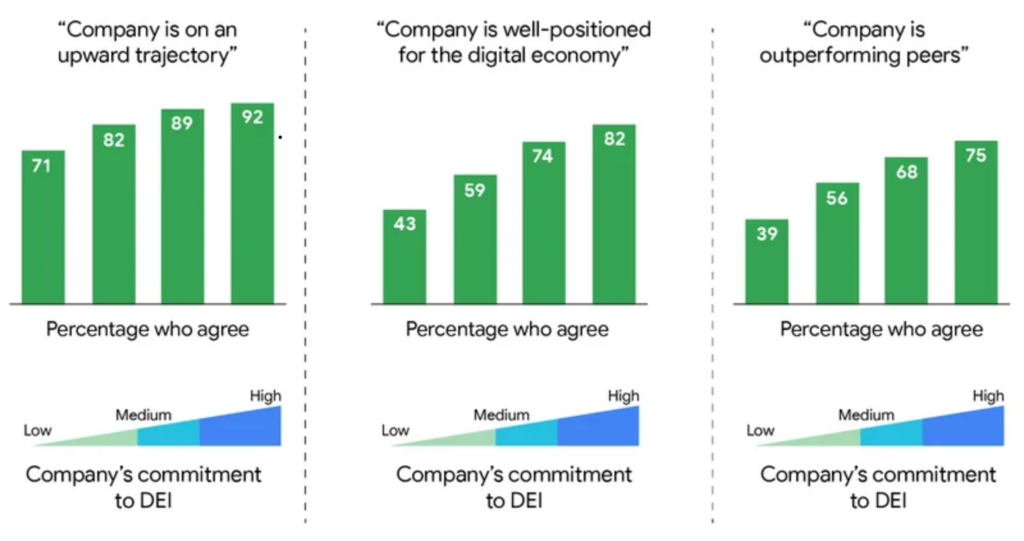9 Ways to Foster an Inclusive Work Environment
Creating an inclusive work environment is a core part of building an organization that values and actively promotes Diversity, Equity, and Inclusion (DE&I). As more and more companies have made inclusivity a strategic priority, another powerful insight has emerged: diverse and inclusive organizations are not just ethically sound, they’re also more innovative and profitable.
In other words: Companies that succeed in creating inclusive work environments not only have happier employees and stronger cultures, they also gain a strategic and competitive advantage.
In this guide, we’ll dive into exactly what an inclusive work environment entails and 9 actionable ways you can create one at your organization today.
What Is Meant by an Inclusive Work Environment?
An inclusive work environment is one that values, respects, and integrates the diverse backgrounds, experiences, and perspectives of all employees. It goes beyond the simple presence of diversity within a workforce and facilitates a culture where every individual—regardless of their race, gender, age, sexual orientation, or disability—feels genuinely valued as an integral part of the team.
Inclusion in the workplace also means all employees have equal access to opportunities and resources, and are empowered to participate fully in the organization. It’s about creating a space where differences are not just tolerated, but are viewed as assets that contribute to the richness of the organization. This requires acknowledging and celebrating these differences, as well as leveraging them to foster creativity, innovation, and problem-solving.
An inclusive work environment also extends to company policies and practices. It’s reflected in how a company recruits, promotes, and retains its workforce. It’s evident in the way conflicts are resolved, in the flexibility of work arrangements, and in the inclusivity of the company’s communications.
In an inclusive work environment, employees feel a sense of belonging and are comfortable sharing their opinions and ideas without fear of discrimination or prejudice. They trust that their unique perspectives are heard and appreciated, and can influence the company’s direction and decision-making.
An inclusive work environment is no doubt an ethical imperative, but its impact also extends to business success. It leads to stronger talent pipelines, higher employee engagement, improved job satisfaction, and greater retention rates. Companies that excel in creating inclusive environments often see enhanced performance, as diverse teams bring a range of skills, experiences, and viewpoints that drive innovation.
Google research found that companies with a higher commitment to Diversity, Equity, and Inclusion are on a more upward trajectory, better equipped for the digital economy, and likely to outperform peers.

That said, creating a truly inclusive work environment requires more than just commitment. It requires active strategies and tactics to facilitate the right culture, actions, and communications from leaders and employees across the organization.
In the next section, we’ll explore 9 actionable ways you can foster a more inclusive work environment at your company right now.
9 Ways to Foster an Inclusive Work Environment
Leadership Commitment
Inclusive work environments start from the top. Leaders should demonstrate a commitment to diversity and inclusivity, setting the tone for the rest of the organization. Further, the makeup of the leadership team should be diverse and representative, demonstrating that diversity is a priority at every level of the organization.
Again, this isn’t only ethically sound but strategically smart. Companies that are more diverse at the executive level are better value creators and are more profitable than less inclusive counterparts.

Inclusive Policies and Practices
Formalizing your company’s DE&I commitment is essential to making it a daily reality. Company policies around fair recruitment, equal pay, and anti-discrimination should all be reviewed and updated regularly to stay aligned with company values.
HR should lead the charge while collaborating closely with C-suite and department leaders. Once policies are updated, they should be shared directly and made easily accessible to all employees.
Diversity Training
Inclusive work environments require ongoing training for all employees. HR, again in conjunction with other leaders at the organization, should design and deliver frequent diversity training to give employees practical resources for how to participate in inclusive culture.
Making training formats interactive is ideal—it ensures employees are engaged in what they’re learning and gain applicable strategies to promote inclusivity, rather than just being lectured on DE&I concepts.
Open Communication Channels
It’s important to create open and safe communication channels where employees can voice concerns and suggestions. This may include regular feedback sessions, anonymous reporting tools, and open-door policies from leaders at your organization.
It’s also essential to stick to your promises about anonymity and follow-through measures for DE&I inquiries, suggestions, and concerns.
Celebration of Diversity
Recognizing and celebrating different cultures, backgrounds, and perspectives is a critical piece to the puzzle for creating inclusive work environments. You can do it through cultural events, acknowledgment of diverse holidays, and diversity awareness initiatives.
Inclusive Language and Communication
Use inclusive language in all company communications. Ensure that marketing materials, job postings and descriptions, and internal communications are free from biased language. Use data-driven approaches to measure the response that your communications yield (ex: diversity in job applicants) and make adjustments as needed to enhance inclusivity.
Simple ways to make job postings and other communications more inclusive include accurately sharing company values, avoiding gender-coded language, highlighting benefits that appeal to diverse audiences, and diversifying communication channels.

Accessibility and Accommodation
Make sure the workplace is accessible to everyone, including those with disabilities and other unique accommodation requirements. This includes physical accessibility as well as tools and technologies that support various needs.
You can go the extra mile by providing flexible work options for people with families, special health needs, or other schedule considerations. Even those without specific accommodation needs or requests will likely feel a stronger sense of belonging when work/life balance is prioritized.
Regular Assessments and Adjustments
Regularly assess the inclusivity of your work environment and make adjustments as new needs, potential improvements, and innovative suggestions are identified. Collect feedback with tactics such as feedback sessions, surveys, and audits that deliver data and insights you can use to make decisions. Document the actions you take to show progress over time.
Using data-driven approaches can also help you identify areas where unconscious bias has played a role–in other words, where inclusivity was compromised unintentionally—and remediate those issues.
Community Engagement and Social Responsibility
Engage with the wider community and take part in social responsibility initiatives. This not only boosts the company’s image but also encourages employees to be part of a larger, inclusive mission.
Putting it All Together
Today, creating inclusive work environments is both an ethical requirement and a strategic advantage. By promoting a culture that values diversity and inclusion—and teaching employees to do the same—you can build an organization that’s both rooted in diverse perspectives and capable of achieving new levels of innovation.
For a deeper dive on the current DE&I landscape and how to navigate it, download our recent report: CMOs & Chief DE&I Officers: Joined at the Hip for a DE&I Revolution.



